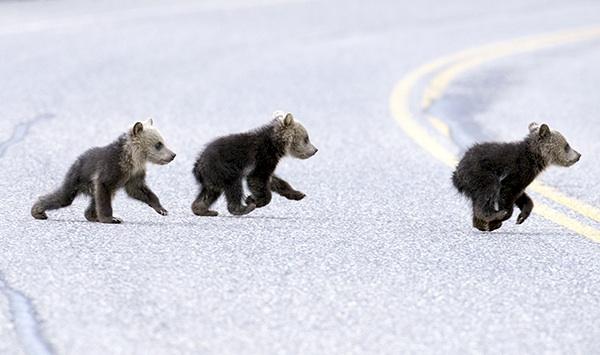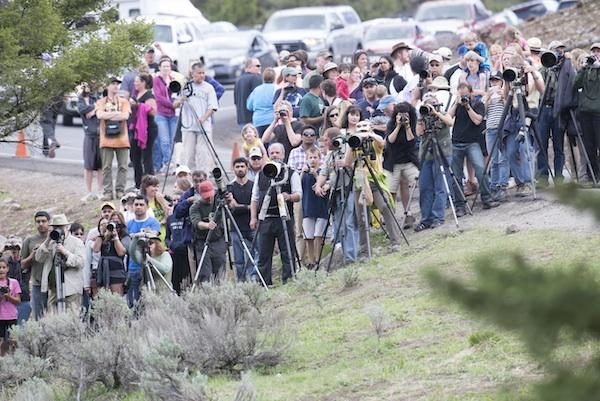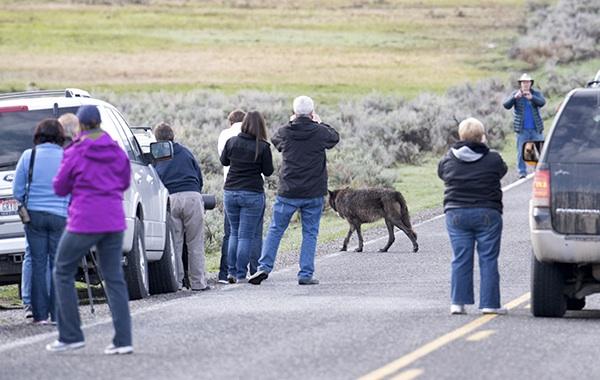
Bear cubs don't always look both ways for oncoming traffic. Sometimes humans should provide that service/Deby Dixon.
What is more important, the animal or the shot?
Nearly every day someone tells me that I have the dream job as a full-time wildlife photographer in Yellowstone National Park, but if they knew that a Dutch photographer nearly punched me out yesterday, when I was trying to assist a black bear in crossing the road on a blind curve, they might think again.
When I arrived in Yellowstone, in October of 2012, to spend the winter learning about wolves, I was a bright-eyed, bushy-tailed photographer who had visions of magnificent shots of the animals as they moved across the landscape.
What I did not count on was that there is much more to wildlife photography then picking up the lens and shooting as they stand still and pose, or run across the sage filled Lamar Valley - much beyond the patience in waiting for the animal to appear, or being in the right position, at the right angle with the right light.
I did not know about the animals themselves and how much they go through while living in a national park. My photographic adventure soon turned to one of advocacy for the wildlife as it relates to many aspects - the hunting of the wildlife, getting too close to the animals and blocking them from moving freely and so much more. Driving cautiously because the animals like to use the roads. My time in Yellowstone, that has now stretched out to nearly two years, has been the greatest, single learning experience of my life.
Not only have I learned that wildlife photography is an extremely competitive and jealous business and my year-around access to Yellowstone does not make me very popular amongst other photographers, but also that the welfare of the animal is more important than the shot.
Yes, I have become an ethical photographer who puts their camera down in favor of helping an animal across the road safely or by removing myself from a situation where the animals are crowded and stressed. And, yes, if need be, I will call upon rangers to come and assist the animals.

Jockeying for that perfect photo/Deby Dixon
Yesterday, someone told me that calling the rangers would only ruin things for myself but what they do not know, is that I have to live with myself. And, so when a black bear sow with three cubs prepares to cross the road on a blind curve, I will alert people to slow down or stop if necessary, in order to keep those animals safe. In the case of yesterday, the cubs did not appear on the road but there was no way to know that when the adult was crossing.
Another wildlife photographer told me that it was okay for them to be close to a sow and three cubs because they were a 'professional wildlife photographer.'
'You are not a professional if you are going to get that close to a sow and three cubs,' I replied. The woman walked off.
The problem for the wildlife is that not only do they have to worry about the visitors with the point and shoot cameras who want to get the same close-up shot as the wildlife photographer, but also the professional photographer who is willing to do anything to any animal or anyone to get the shot.
Meaning that photographers will step in front of and prevent other photographers from getting their shots, while some will use animal calls to lure the bird or wolf to their lens. Others will feed the animals - such as supplying owls with mice or fresh road kill.
I do not believe that the majority of the wildlife photographers, or visitors with point and shoot cameras, intend the animals any harm when they get too close or they feed them, but that they do not fully understand the cause and effect of such actions. I believe this because I did not understand much about the animals and the integrity of wildlife photography until spending nearly every day of the year inside of Yellowstone and watching the problems play out time and time again.
Animal calls make the wildlife easy prey for hunters and poachers and feeding an animal can make it become aggressive towards humans in its attempt to extract food. Being too close to the animals can make them lose their fear of humans, making them easier prey for hunters and some times causing them to be too comfortable around the roads and places where people congregate. These are just a few of the problems related with not giving the animals their wild spaces and allowing them to be free to move about. Animals can be caused to spook and run into the path of a car or in the direction of a predator.
It is our responsibility to alter the animal's behavior as little as possible in order to keep them safe. After all, if the animal is dead our photo ops have ended.
Now, having said all of this, I am not perfect. I, quite often, find myself closer to the animal then is allowed in the national parks, but this is usually due to the animal moving closer to me, rather than me moving closer to them. I tend to read the animals and watch their eyes and behavior for signs of stress. When an animal is grazing peacefully beside the road, they are doing fine, as long as I am not going any closer to them.

How close to wildlife is too close?/Deby Dixon
Just two days ago, I watched as an habituated wolf - one that has been way too comfortable around humans - was hazed by a law enforcement ranger. The beautiful wild wolf has had a habit of coming way too close to people who have watched her in the landscape and she has done so without any signs of aggression whatsoever. I believe that she is just curious about us and wants to check us out, which would end in fatal consequences if she were to leave the park during hunting season.
The law enforcement ranger hit her with a bean bag and then fired a cracker shell between her and the people and road. The wolf took off running for the hills, hopefully a little less curious about humans. For myself, I would rather see this wolf safe then to ever get another close shot of her because she came too close.
So, the next time that you go to photograph an animal, ask yourself, is this animal safe or am I causing it harm. Then, ask yourself, will I enjoy looking at this shot later, knowing the full story about how it came to happen. I have many photos in my folders of times when an animal was photographed under less than ideal circumstances and even though they might be terrific images, the story behind the shot never goes away.



Comments
Hah, that's a classic!
Reminds me of a time in Yellowstone. I was photographing buffalo with their calves in the Madison area when I was "stuck" in the trees as two lines of buffalo were paralleling me. While I waited them out in the trees I saw a family of four pull up by my wife and get out of their car. She heard them talking and as the father and two young children started to head for the buffalo my wife was pointing to me to watch them. I figured they would get to close so I got my camera ready for that "what not to do in a NP" shot but the father came to his senses and stopped moving forward much to the dismay of his wife. She took their picture then huffed and stormed back to the car and they left. When I finally got back to my wife she told me what happened. When the husband faltered and questioned his wife's direction, she told him to take the kids and get closer. He asked if she was sure and (this is the best part) she said "yeah, this is a National Park, they wouldn't put wild animals in here". I almost died laughing when I heard that part.
What do you get when you cross a tourist with a moron? We call them tourons!
Tourons.
Gonna have to remember that. It's perfect.
I'm not sure what's more of a spectacle, the animals or the photographers. I think I'd be ashamed to be part of that group.
Yes, great article. I was fortnuate enough to be at Yellowstone earlier this month. I'm only a hobbyist photographer - but I love Yellowstone for both the wildlife and the scenery. I do consider myself and ethical photography. My family and I have spent a lot of time outdoors and try very hard to avoid any impact to the wildlife - both for our safety and theirs. But it is truly sad and amazing to see the tourons (I do like that term!) and some of the stupid human tricks. From the way they "park" their cars to running at the wildlife screaming and throwing food - often with small children in tow (thereby learning the same stupid moves). The rangers (once they're able to get there through the traffic) do an amazing job not only trying to control the crowds and traffic while protecting the wildlife (and the tourons), but they also show tremendous restraint when dealing with the tourons. I'm not sure I'd be able to keep my thoughts to myself when I see some of the tourons in action. So I applaud the Rangers and how they handle themselves and those situations where people really need to be smacked. One Ranger I spoke with (while we were east of Fishing Bridge watching a Grizzly from a safe distance) shared some examples of stupd human tricks and it was scary. It's too bad the National Parks can't make a rule against 'stupid' and start writing tickets for it. After 3 strikes, you shouldn't be allowed back in the Park.
Dittos Deby Dixon, a very nice article balanced between the "keep it wild", yet still empathetic to us human beings. I always resisted saying the visitors were stupid; curious, unaware or uneducated to the issues sometimes, maybe, and of course there is the occasional miscreant (perhaps to strong a word), but great article. Thank you.
Thanks Ron for your resistence. It makes one wonder when those that are hired to serve are so anxious to ridicule their employers - the people.
I agree EC, rude or abusive behavior towards citizens by public service employees is simply unacceptable. But it works both ways, citizens need to rein it in occasionally, get the facts, try to open civil dialog; public employees have the same expectation of civil behavior from the citizens that the citizens expect from their governmental employees. I do think malfeasance, governmental or in the private sector, deserves comment and there should be consequences, but the same applies in the private sector. i also would like to thank "Traveler" for the informative and education articles, as well as this forum, but I agree with "Traveler", that comments posted should stick to the issues, we should try to stay away from personal attacks.